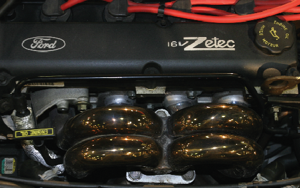OBD II-compliant vehicles must meet specific exhaust system design parameters to prevent setting false engine management trouble codes. 
To illustrate, engine management systems using an electronic airflow sensor can calculate air/fuel ratio by measuring the exact weight of air flowing into the engine.
Speed-density engine management systems, on the other hand, might use a combination of engine speed, throttle opening, barometric pressure, intake manifold vacuum, coolant temperature and intake air temperature values to estimate the weight of intake air flowing into the engine.
Installing a performance exhaust might reduce exhaust backpressure enough to cause the PCM to perform an inaccurate calculation of air flowing into the engine. The vehicle might, therefore, experience driveability and emissions failure issues caused by an inaccurate air flow calculation.
Consequently, installing a dynamometer-tested, aftermarket exhaust system kit might be the shortest route to improving exhaust efficiency on an OBD II-compliant vehicle. If the vehicle is being used for off-highway performance, a programmable engine management system is usually installed so that air-fuel calibrations can be modified to conform to the parameters required by a high-performance exhaust system.
In any case, from installing a chrome-tipped extension on a factory exhaust to installing a full-blown competition exhaust system, there’s money to be made by selling performance exhaust modifications.
Exhaust System Installation
When installing the downstream exhaust system, remember that smaller-diameter exhaust pipes are generally better because they help maintain pressure wave velocities and are less likely to radiate heat into the passenger compartment or into a vehicle’s fuel and brake lines.
Keep in mind that most OE catalytic converters that are in good condition rarely create backpressure in the exhaust system. On the other hand, an OE-style baffled muffler is designed to reduce noise by breaking up the pressure wave in the exhaust stream.
Consequently, a “straight-through” muffler design is generally more desirable. If you’re in doubt about muffler or converter choice, the exhaust backpressure can be tested by tapping into the upstream oxygen sensor mount. Exhaust gas pressure should be as close to zero as possible for performance applications.
Exhaust gas turbulence can be slightly reduced by making sure exhaust pipe joint diameters become progressively larger. Similarly, smooth, large-radius pipe bends are more efficient at preserving exhaust gas velocities. When an exhaust pipe must be routed close to floor panels or fuel and brake tubing, the pipe can be wrapped with “header wrap” and held in place with worm-type radiator hose clamps. Conversely, vital components can be shielded with a heat-reflecting wrap available from speed shops and online performance warehouses.
Builders of tuned exhaust systems attempt to maintain the velocity of the exhaust gas pressure wave by carefully contouring the exhaust port and exhaust manifold “header” pipe to reduce turbulence. The exhaust port and header pipe diameter must be large enough to prevent restriction, but small enough to maintain gas velocity. Some racers attempt to keep exhaust gas temperatures high by wrapping individual exhaust tubes with an insulating material called “header wrap.”
Increasing exhaust manifold pipe diameters above an optimum size causes the exhaust gas pressure wave to rapidly dissipate and lose its effectiveness in helping draw the intake charge into the engine’s cylinders. In general, higher engine speeds require slightly larger pipe diameters. For most street-driven vehicles, the smaller diameter is usually the better choice.
Exhaust pipe tips should always extend past the vehicles’ body perimeter to help prevent poisonous carbon monoxide from being drawn into the vehicle. Make sure that rear trunk, hatch and window moldings seal correctly to prevent exhaust gas from being drawn into the vehicle.













